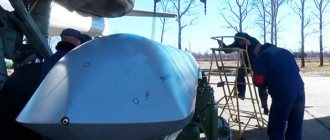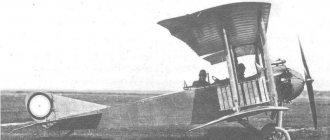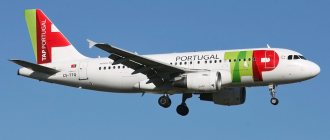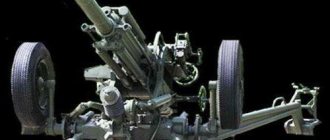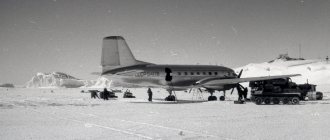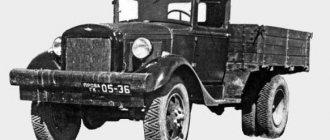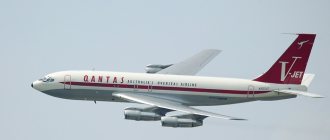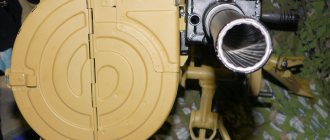Il-18 (NATO encoding: “Simp” (Coot)) is a passenger aircraft for medium-range airlines, made according to the design of a turboprop four-engine low-wing aircraft. Single fin. The first turboprop Soviet airliner.
History of creation
In the 1950s, when it became obvious that passenger aircraft equipped with piston engines were not meeting the rapid growth of air travel, a need arose for high-speed and spacious aircraft equipped with gas turbine engines. The Tupolev Design Bureau decided to create a passenger aircraft based on the Tu-16 jet bomber Tu-104. The Ilyushin design bureau decided to design a passenger aircraft equipped with a theater engine.
On May 25, 1956, Resolution No. 703-404 of the Council of Ministers of the Soviet Union was adopted on the creation of the Il18 passenger aircraft with four turboprop engines. The preliminary design of Il18 was approved by S.V. Ilyushin on August 26, 195, and in September 1956 construction of the first experimental model began. In June 1957, at the Central Aerodrome of Moscow, the leaders of the government and party, headed by N. S. Khrushchev, held a review of the first Il18; at the suggestion of the First Secretary of the Moscow City Committee of the CPSU, E. A. Furtseva, the aircraft was given the name “Moscow”.
The prototype made its first flight on 07/04/1957, flying from the Central Airfield named after M.V. Frunze to the city of Zhukovsky (flight duration - 1 hour 57 minutes). Aircraft equipped with AI-20 and NK-4 engines took part in the tests. The test results showed that the AI20, designed by A. G. Ivchenko, is more reliable, so it was chosen for installation on production aircraft.
The experimental aircraft were designed for 75 people. In 1958, they created the Il18A variant, which had a take-off weight of 58 tons and a passenger compartment increased to 89 seats. This was the first model in the series. Due to unreliable engine operation, the use of Il18A aircraft with NK-4 engines was discontinued in January 1959. The Il8B modification with a payload increased to 14 tons and a higher take-off weight (61.5 tons) appeared in the same 1958. On April 20, 1959, the first two passenger flights of the Il18 took place on the route Adler-Moscow and Alma-Ata-Moscow.
In 1960, the Il18V was created, which differs from the Il18B variant in an increased level of amenities and the use of excellent flight and navigation equipment.
In 1965, the OKB designed the Il18E aircraft, which was designed for 120 seats and had an even more comfortable cabin. The latest passenger model is the Il18D aircraft, on which the AI20M was used instead of the AI20K theater, fuel tanks were added in the wing center section, and an approach control system was installed. Thanks to the additional fuel, the flight range is increased.
IL-18 salon
In addition to passenger aircraft, other variants were created at the Design Bureau: cargo, service, patrol aircraft, including:
- anti-submarine Il38;
- electronic warfare aircraft Il20;
- Il22 air command post;
- Il24 ice reconnaissance aircraft.
One of the Il-18V aircraft was converted for flights to Antarctica: additional fuel tanks were installed in the passenger cabin, which made it possible to increase the fuel supply (31 thousand liters). It should be noted that the Moscow-Antarctica relay race was served, as a rule, by Il18 aircraft flying in the skies of Africa, simultaneously carrying cargo and passengers on regional airlines.
In 1958-1959, twenty world records for altitude and flight range with different payloads were set on Il18 aircraft.
Il18 aircraft, due to their efficiency, level of comfort and safety, aroused interest in the world market, so most foreign companies bought these aircraft. It became the first Soviet passenger aircraft, which was in great demand worldwide: over 100 aircraft were built for seventeen foreign companies.
It was serially produced at, which was located on Khodynskoye Field near the Central Airfield in Moscow from 1959 to 1978.
IL-18 Engine. Dimensions. Range of flight. Practical ceiling. Story
The first passenger aircraft with this name was built in the summer of 1946. Its power plant consisted of four ASh-73 piston engines. Flight tests of the aircraft, designed for 60 seats, were conducted by test pilot V.K. Kokkinaki. The experience of creating and testing the Il-18 aircraft with piston engines had a significant influence on the design of the Il-18 turboprop aircraft, which retained the name of its predecessor, but was essentially a completely new aircraft.
Speed limits
Max.
operational speed at altitudes, Vmax e – from 0 to 5000 m – 600 km/h PR – from 5000 m – 615 km/h PR Max. operational number M, Mmax e – 0.75 Max. add. landing gear extension speed, Vmax h.a.w. – 405 km/h Max. add. flight speed from issue. chassis, Vmax w. – 405 km/h Max. additional speed of slats extension by 20 degrees, Vmax pr – 405 km/h Max. additional flap extension speed of 20 degrees, Vmax 3 – 405 km/h Max. additional flap extension speed at 30 degrees – 360 km/h Max. additional flap extension speed at 45 degrees – 305 km/h Max. additional headlight release speed – 500 km/h Minimum permissible flight speed with the mechanization removed: – from circle altitude to 3000 m – 330 km/h PR – from 3000 to 7000 – 370 km/h PR – from 7000 – 410 km/h PR max. add. speed based on the strength of tires and wheels – 325 km/h Speeds
| weight 55 t | weight 50t | weight 46t | |
| Stall speeds: Vс1 and Vс0 | Slats 0, flaps 0 | 250 km/h | 227 km/h |
| Slats 20, flaps 20 | 182 km/h | 173 km/h | 164 km/h |
| Slats 20, flaps 45 | 172 km/h | 163 km/h | 155 km/h |
| Front support lifting speed Vp.st. | 215 km/h | 203 km/h | 196 km/h |
| Safe takeoff speed V2 | 235 km/h | 223 km/h | 216 km/h |
| Speed of start of change of position of mechanization V3 | 280 km/h | 265 km/h | 255 km/h |
| Safe speed 1.25Vс1 – initial climb speed | 312 km/h | 295 km/h | 285 km/h |
| Approach speeds Vzp | 216 km/h | 206 km/h | 205 km/h |
| Landing speed | 185 km/h | 176 km/h | 175 km/h |
at takeoff mode - no more than 5 minutes (100-115%) at nominal. – not limited (91%) – for climb (hourly fuel consumption – 4100 kg) max. cruising - (81%) - for flight at flight level (hourly consumption - 3650 kg) flight low gas (60%) - minimum permissible flight mode (hourly consumption 2700 kg) at cruising - not limited (50-84%) at low gas - no more than 30 minutes (39-44%) - used when performing descent from flight level and emergency descent (hourly flow - 785 kg) max. additional t of gases behind the low pressure turbine - up to an altitude of 6000 m - 600 degrees C above 6000 m - 650 degrees C max. low pressure rotor speed, nnd – 90% max. high-pressure rotor speed, nvd – 100% fan rotor speed rate at engine take-off mode – 90-95% at maximum cruising mode – 82-90% oil pressure at the engine inlet – at MG and PMG modes – at least 2 kgf/ cm2 – above PMG – 3.0-4.5 kgf/cm2 oil temperature at the engine inlet – min. permissible at startup – -40 degrees C – max. permissible - 110 degrees C fuel pressure at working injectors - no more than 80 kgf/cm2
Max. cruising altitude – 9100 m max. add. maneuvering overloads, ny additional – in the flight configuration of the aircraft – -0.5/+2.5 – in the landing configuration – 0/+2.0 max. add. roll angles – at altitudes over 200 m – 300 – at altitudes less than 200 m – 150 critical angle of attack, additional – 17 degrees.
Il-18 aircraft - video
Initially, a version of the Il-16 passenger aircraft was developed with a swept wing and tail and equipped with four AM-11 turbojet engines installed in the wing root. The design bureau had already begun developing working drawings and carried out an extensive set of aerodynamic studies, but then all work was curtailed and the topic was closed. The reason was the Tu-104 passenger aircraft, which began flight tests in 1955.
The issue of creating civil aircraft for Aeroflot airlines was discussed at government meetings with the participation of chief designers; at first it was decided to create a multi-purpose aircraft, used both as a passenger and as a transport aircraft. S.V. Ilyushin defended the idea of a specialized passenger aircraft with its inherent classical design, allowing for the creation of a highly efficient machine, believing that the flight characteristics of a multi-purpose aircraft would be worse. This idea was recognized as correct, and OKB S.V. Ilyushin began creating such an aircraft on the basis of a decree of the USSR Government of May 25, 1956.
The Il-18 aircraft was a low-wing monoplane powered by four NK-4 turboprop engines. The engine thrust was selected based on the flight conditions in case of failure of one or two engines. The aerodynamic configuration of the aircraft, perfect for that time, provided it with high performance characteristics. The IL-18 was designed for 75 passenger seats or 12 tons of commercial cargo, had two salons, with 10 and 65 seats respectively, separated by a buffet.
Construction of the first prototype aircraft began in September 1956 and was completed in less than a year. In June 1957, the aircraft was demonstrated to N.S. Khrushchev, and at the suggestion of E.A. Furtseva’s car was named “Moscow”.
The aircraft made its first flight on July 4, 1957 with a crew led by test pilot V.K. Kokkinaki. After the completion of state tests, factory tests of a production aircraft with AI-20 engines began. Serial production began in November 1957 (567 vehicles were produced). For the creation of the Il-18 aircraft in 1960, seven people were awarded the Lenin Prize, including S.V. Ilyushin and V.K. Kokkinaki. Over the years, this aircraft has set many world records for speed and flight range.
Modifications
Il-18 “Salon” - Aircraft for special transportation of high-ranking government officials. Aircraft of this modification were repeatedly used by N. S. Khrushchev and L. I. Brezhnev. Il-18 "Salon" (tail number USSR-75717) on April 14, 1961 delivered Yu. A. Gagarin to Moscow after his historic flight into space. Based on orders from Aeroflot and foreign airlines, 10 variants of cabin layouts were developed ("22A", "29A", "39A"). In 1956-1969 About 20 Il-18B, Il-18V and Il-18D aircraft were converted into “Salon” variants.
IL-18 “Stripe” - Experienced with a complex of navigation and flight equipment that allowed automatic flight along the entire trajectory. In 1965, 1 aircraft was converted.
Il-18A - The first production aircraft with NK-4 engines. Total mass-produced in 1958-59. 42 copies of Il-18A. Due to unreliable engine operation, the operation of Il-18A aircraft with NK-4 engines was discontinued in January 1959. Later they were converted into Il-18B aircraft.
Il-18B - Aircraft with AI-20 engines began to arrive at Aeroflot from the beginning of 1959. In 1958-1959. 64 cars were built.
Il-18V is an improved aircraft with three passenger cabins.
Il-18V-26A (Il-18D) - Aircraft for long-distance flights. It featured an increased fuel reserve, a comfortable cabin for 20 passengers, and additional flight and navigation equipment. In 1962, 3 aircraft were manufactured. Used for flights to Antarctica.
Il-18Gr - Cargo. It is distinguished by the absence of passenger equipment, a reinforced floor, and a rail with a hoist on the ceiling of the cabin. First flight March 4, 1978. Since 1978, aircraft repair plants have refurbished passenger aircraft that had not reached the end of their service life.
Il-18GrM - Cargo modified. It is distinguished by the presence of a large cargo door on the left side, floor mechanization (layouts “41” and “42A”). Developed in 1978. In 1990-1996, several Il-18D aircraft were converted.
Il-18D - Model with increased range and commercial load with AI-20M engines. In 1965-1969 122 Il-18Ds were built.
Il-18D "Pomor" - Fishing reconnaissance aircraft. 1 Il-18D was converted.
Il-18DC "Cyclone" - Aircraft for meteorological research. First flight April 4, 1980.
Il-18DORR - Aircraft for long-range detection of fish resources. First flight in April 1985. 2 aircraft were manufactured.
IL-18E - A car with an increased number of seats (up to 100...110) and a modified air conditioning system, the interior trim has also been improved. In 1965-1966, 23 cars were produced.
IL-18LL - Flying laboratory. At LII named after. M. M. Gromov converted several aircraft.
Il-18RT (Il-18SIP) - Aircraft measuring point. It was distinguished by equipment for receiving and recording telemetric information, and 15 operator workstations in the cabin. In 1964, 2 Il-18Vs were converted.
IL-18RTL - Prototype of IL-20RT. It was distinguished by a large antenna fairing on top of the fuselage. Converted 1 Il-18 in 1971 to the Flight Research Institute named after. M. M. Gromova.
Il-18T (Il-18AT, BT, VT) - Transport and sanitary. It was distinguished by the absence of chairs, toilets and wardrobes. First flight February 29, 1960. Converted from passenger aircraft.
Il-18TD - Transport-landing. Made in 1 copy in 1968.
Il-18USH - Training navigator. It featured 20 navigator workplaces in the cabin. Developed in 1972. Several aircraft have been converted.
Weight parameters
The maximum take-off weight of the Ilyushin-18 airliners, models B and C, is 61,400 kg, and the Ilyushin-18D is 64,000 kg.
It can be increased, but not by more than 500 kg, since when testing the engines and taxiing the aircraft from the airport terminal to the launch site, the corresponding amount of fuel will be used up.
The maximum landing weight of the Ilyushin-18 models B, B and E is 52,000 kg, and the Ilyushin-18D is 52,600 kg. Landing of an airliner with a weight exceeding the permissible landing weight, including landing with the highest take-off weight, is permitted only in special cases. At the same time, the pilot is required to concentrate.
The maximum commercial load for modifications is 13500 kgf. This includes the weight of passengers, various cargo, and food supplies in the kitchen buffet. At its highest payload, the aircraft can travel a distance equal to approximately half of its maximum flight range.
The maximum fuel reserve (taking into account the density of 0.785 g/cm3) for the Ilyushin-18D aircraft is 23550 kg, for other modifications - 18600 kg. The largest amount of fuel that can remain at the time of landing is 10,000 kg.
IL-18 salon
Similar
An-24 Engine. Dimensions. Range of flight. Practical ceiling. Story
Tu-154 Speed. Dimensions. Weight. Capacity. Fuel consumption. Story
Yak-40 Engine. Dimensions. Capacity. Range of flight. Practical ceiling. Story
An-2 Engine. Dimensions. Story. Range of flight. Service ceiling
Tu-144 Engine. Dimensions. Range of flight. Practical ceiling. Story
IL-96 Speed. Dimensions. Capacity. Story. Load capacity
IL-62 Engine. Dimensions. Range of flight. Practical ceiling. Story
IL-18 Engine. Dimensions. Range of flight. Practical ceiling. Story
IL-14 Engine. Dimensions. Story. Range of flight. Service ceiling
An-14 Pchelka Speed. Dimensions. Weight. Capacity. Story. Load capacity
An-148 Speed. Price. Dimensions. Story. Capacity. Fuel consumption
Yak-42 Speed. Dimensions. Capacity. Fuel consumption. Story. Range of flight
Tu-114 Speed. Dimensions. Weight. Capacity. Story. Load capacity
Yak-12 Speed. Dimensions. Weight. Story. Capacity. Load capacity
An-3 Engine. Dimensions. Range of flight. Service ceiling
IL-114 Engine. Dimensions. Range of flight. Service ceiling
Yak-52 Engine. Dimensions. Range of flight. Service ceiling
Tu-334 Speed. Dimensions. Weight. Story. Capacity. Range of flight
Tu-134 Speed. Dimensions. Capacity. Fuel consumption. Story. Range of flight
IL-86 Engine. Dimensions. Range of flight. Service ceiling
Tu-204 Engine. Dimensions. Range of flight. Practical ceiling. Fuel consumption. Price
Tu-104 Engine. Dimensions. Story. Range of flight. Service ceiling
Su-29 Engine. Dimensions. Range of flight. Practical ceiling. Story
Su-31 Speed. Price. Dimensions. Story. Load capacity
Tu-124 Speed. Dimensions. Capacity. Weight. Story. Range of flight
Su-26 Engine. Dimensions. Range of flight. Service ceiling
An-10 Speed. Dimensions. Weight. Story. Capacity. Load capacity
An-140 Speed. Price. Dimensions. Capacity. Fuel consumption. Story
MiG-8 Duck Engine. Dimensions. Story. Range of flight. Service ceiling
Be-30 / Be-32K Engine. Speed. Dimensions. Range of flight. Service ceiling
An-38 Speed. Dimensions. Weight. Story. Capacity. Range of flight
Be-103 Speed. Price. Dimensions. Weight. Story. Capacity
IL-103 Engine. Dimensions. Capacity. Load capacity. Range of flight. Service ceiling
LK-1 (NIAI-1 Plywood-2) History. Dimensions. Engine. Range of flight
ANT-20 Maxim Gorky Speed. Story. Engine. Dimensions. Range of flight
Tu-110 Engine. Dimensions. Range of flight. Practical ceiling. Story
Yak-58 Speed. Dimensions. Weight. Story. Range of flight. Service ceiling
Aviatika-MAI-890 Engine. Dimensions. Speed. Range of flight. Service ceiling
Yak-50 Speed. Dimensions. Story. Range of flight. Service ceiling
Yak-55 Speed. Dimensions. Weight. Story. Range of flight. Service ceiling
IL-12 Engine. Dimensions. Story. Range of flight. Service ceiling
ANT-35 (PS-35) Engine. Dimensions. Story. Range of flight. Service ceiling
Airplane K-5 Engine. Dimensions. Story. Range of flight
KhAI-1 Engine. Dimensions. Story. Range of flight. Service ceiling
Yak-53 Dimensions. Range of flight. Weight. Service ceiling
MAI-223 Kitten Photo. Video. Characteristics. Engine
AIR-6 Engine. Dimensions. Story. Range of flight. Service ceiling
PS-89 (ZIG-1) Engine. Dimensions. Story. Range of flight. Service ceiling
SAM-5 Engine. Dimensions. Story. Range of flight. Service ceiling
Airplane Steel-3 Engine. Dimensions. Story. Range of flight
Airplane ANT-1 Engine. Dimensions. Story. Range of flight
Airplane U-8 Little Humpbacked Horse History. Dimensions. Engine
Airplane K-1 Engine. Dimensions. Story. Range of flight
Design characteristics
The length of the airliner reaches 35.90 m. Height is 10.17 m. Capacity depends on the modification and ranges from 88-122 passenger seats. The aircraft reaches speeds of up to 630 km/h. Cruising speed (during flight with maximum load) is 610 km/h.
Other technical specifications:
- The fuselage diameter is up to 3.5 m.
- Wingspan - 37.4 m.
- Wing area - 140 sq.m.
- Fuel capacity - 30 tons.
- Crew - 5 people.
The weight of the airliner at zero load is 32.245-33.76 tons. The maximum weight at takeoff reaches 67 tons. At maximum load this figure is 48-53 tons.
Exploitation
For the period 1958-1959. pilots of the Ilyushin-18 aircraft set a huge number of world records (twenty!) in flight range with various payloads and at different altitudes.
The commercial operation of this airliner lasted for 43 years - from 1959 to 2002.
After this, the Ilyushin-18 actually ceased to serve as a passenger aircraft in Russia, turning into a cargo aircraft. As of January 2006, 3 out of 11 liners were transporting cargo in Afghanistan and the countries of equatorial Africa.
Although the mass decommissioning of these machines began back in 1977.
In 2010, the RA-75713 model was used as a permanent cargo aircraft on the Petrozavodsk – Naryan-Mar route and made about five flights per week.
In countries such as Ukraine, North Korea, India, Somalia and some others, the Il-18 is still in use.
History of creation
At the aviation festival in Tushino, the new aircraft was shown for the first time. Traditionally, this event was attended by Joseph Stalin, who a few days later summoned Sergei Ilyushin and asked him several questions. One of them was the issue of capacity. When the engineer announced the figure of 75 people, Stalin noted that passenger aviation should first of all be responsible for the safety of passengers and recommended that Sergei Vladimirovich curtail all work on the Il-18 project.
From that moment on, the only copy of the aircraft of this family, built in 1946, flew in parades and took part in various tests until it was decommissioned in the early 50s. Although with his decision the Soviet pilot put an end to the fate of the aircraft, he was not in his power to change the global trends in the development of passenger aviation.
In the middle of the last century, the USSR experienced an unprecedented economic growth. With great enthusiasm in the post-war period, people rebuilt the country, new cities grew, and the need for long-range aviation matured every day.
The Khrushchev Thaw gave new impetus to the development of the Soviet aviation industry. The development of virgin and Siberian lands increased the passenger flow of specialists to these regions of the Soviet Union significantly. This is where the development of the Ilyushin Design Bureau came in handy, which unexpectedly received a second life, but with a turboprop engine.
Interesting Facts
- According to official data, as of 2010, 100 IL-18 aircraft in the world crashed or could not be repaired; the accidents led to the death of 2,352 people.
- Statistics show that in the territory of the Soviet Union, later the Russian Federation and the CIS, no flight accidents due to failures of engines and systems of the Il-18 aircraft were recorded; in total, 16 accidents occurred until 1977, and five of them occurred during landings at SMU in the mountains.
- Among Il-18 pilots, it was nicknamed “Dolphin” because of the characteristic shape of the radar nose cone.
- IL-18 was the hero of episodes of many feature films; it appeared on screens in 12 films.
- Vladimir Vysotsky mentioned the Il-18 in the song “I wish I wasn’t afraid of flying.”
- In 20 cities, five of them in Western Europe, the rest in the territory of the former USSR, there are monuments to the legendary Il-18 passenger airliner.
IL-18
Due to its efficiency, comfort and safety, the Il-18 was for a long time the main passenger aircraft of the USSR for medium-haul airlines. Production of the Il-18 continued from 1958 to 1970. Further priority was given to the development of jet aircraft. Despite this, a number of IL-18s are actively in service to this day.
History of creation
In the mid-1950s, when it became clear that piston-engined passenger aircraft were not meeting the rapid growth of air travel, the need arose for larger, faster aircraft powered by gas turbine engines. At OKB im. Tupolev took the path of creating the Tu-104 passenger aircraft based on the Tu-16 jet bomber. The Ilyushin Design Bureau decided to design a passenger aircraft with a theater engine.
On May 25, 1956, Resolution No. 703-404 of the Council of Ministers of the USSR was adopted on the creation of the Il-18 passenger aircraft with four turboprop engines[5]. The preliminary design of the Il-18 was approved by S.V. Ilyushin on August 26, 1956, and construction of the first prototype aircraft began in September of the same year[6]. In June 1957, at the Central Airfield in Moscow, the first Il-18 was inspected by the leaders of the party and government, headed by N. S. Khrushchev, at the suggestion of the First Secretary of the Moscow City Committee of the CPSU E. A. Furtseva, the aircraft was given its own name: “Moscow”[ 7].
The experimental aircraft made its first flight on July 4, 1957, flying from the Central Airfield named after. M.V. Frunze to the flight base in the city of Zhukovsky (flight duration - 1 hour 57 minutes)[8]. The tests involved aircraft equipped with NK-4 and AI-20 engines. The test results showed that the AI-20, designed by A. G. Ivchenko, is more reliable, and it was chosen for installation on production aircraft.
The prototype aircraft were designed for 75 seats. In 1958, the Il-18A version was created with a take-off weight of 58 tons and a passenger compartment increased to 89 seats. This was the first production model. Due to unreliable engine operation, the operation of Il-18A aircraft with NK-4 engines was discontinued in January 1959. A modification of the Il-18B with a payload increased from 12 to 14 tons and an increased take-off weight to 61.5 tons appeared already in the same 1958. On April 20, 1959, the first two passenger flights of the Il-18 took place on the route Moscow - Adler and Moscow - Alma-Ata[2].
In 1960, the Il-18V was created, which differed from the Il-18B version in its increased level of comfort and the use of more advanced flight and navigation equipment.
In 1965, the OKB developed the Il-18E aircraft, designed for 120 seats and having an even more comfortable cabin. The latest passenger model was the Il-18D aircraft, on which the AI-20M was used instead of the AI-20K theater, fuel tanks were added in the wing center section, and an approach control system was installed. Due to additional fuel, the flight range was increased.
In addition to passenger aircraft, the OKB created various options: service, cargo, patrol, including:
- electronic warfare aircraft Il-20;
- Il-22 air command post (about 30 units were produced in the 1970s-1980s[9]);
- Il-24 ice reconnaissance aircraft;
- anti-submarine IL-38.
One of the Il-18V aircraft was converted for flights to Antarctica: additional fuel tanks were installed in the passenger cabin, which made it possible to increase the fuel supply to 31,000 liters. It is noteworthy that the Moscow-Antarctica relay race, as a rule, was served by Il-18 aircraft, which flew in the skies of Africa, simultaneously carrying out passenger and cargo transportation on local airlines.
During 1958-1959, Il-18 aircraft set twenty world records for flight range and altitude with various payloads.
Il-18 aircraft, due to their efficiency, level of comfort and safety, aroused interest in the world market, so many foreign companies purchased these aircraft. The aircraft became the first Soviet passenger aircraft that was in great demand on the world market: over one hundred aircraft were built for seventeen foreign companies.
Unlike the Tu-104 and Tu-114 airliners, created on the basis of the military strategic bombers Tu-16 and Tu-95, the Il-18 became the first passenger airliner in the USSR, designed from scratch, initially as a civilian passenger aircraft.
First day envelope - Ultra long-range flight Il-18D Moscow - Antarctica - Moscow February 10
Starting engines from a battery
STARTING THE APU 1. Turn on the LEV and RIGHT battery switches 2. Turn on the batteries with the BATTERY ON switch. 3. On the left panel of the AZR, turn on the protection circuit breakers: SAS BC, SAS LEV, VHF LEV. SPGU, APSH 115 V LEV, APSH 36 V LEV, AVAR. 115-36V, FIRE EXTINGUISHER. I TURN., FIRE FIGHTING AUTON., FIRE SIGNAL N1 4. On the right panel of the AZR, turn on the circuit breakers: SAS MEDIUM, SAS RIGHT, SIREN, VHF RIGHT. SPGU, APS 115 V RIGHT, APS 36 V RIGHT, APU GEN, EXTINGUISHING II STAGE, FIRE SIGNAL N2 5. On the top panel, turn the EMERGENCY 115 MANUAL-AUTO switch to the MANUAL position. Check the voltage of the on-board batteries - at least 24V 6. Turn on the APU power supply (APU POWER switch) In this case, the signal lamps should light up: FLAP CLOSED, PUMP ON, APU FUEL FIRE PLUG OPEN 7. Open the APU flap - FLAP OPEN-CLOSE switch to the OPEN position . In this case, the signal board READY APU FOR START should light up 8. Install the START-COLD CLEAR switch. to the START position 9. Press the APU START button. In this case, the display GOT APU START will go out and LAUNCH D-36, APU 10 will light up. Check the operating parameters of the APU. (tgas no more than 680 degrees) Time to reach idle mode – 18-45 s 11. On the top control panel, turn on the APU GEN and move the EMERGENCY knob to 115-AUTO-MANUAL. to the AUTON position 12. Stop starting the APU - STOP button. 13. Set COLD 14. Turn on the APU AIR BLEED STARTING D-36 ENGINES is done in the order RIGHT, MIDDLE, LEFT 1. Install the vibration sensors in the position of the engine being started. 2. Set the fuel pump protection circuit breakers to the ON position 3. The fire valve of the engine being started is in the OPEN position 4. Unlock the rudders and ailerons 5. On the left console, turn on the ESU 6. On the START ON GROUND panel, set the D-36 circuit breaker to the START position 7 .Set the START-COOL PROC switch to the START position 8. 1 minute after turning on the air bleed from the APU, set the ROD of the engine being started to the START position 9. Move the throttle of the engine being started to the LOW position 10. Press the D-36 START button for 2-3 s 11. Remove the ROD to the STOP position 12. Press the button (1-2s) START START 13. Turn on the generator GENERATOR LEFT. 14. Turn off the APU generator 15. Turn off the START circuit breaker 16. Set the COLD PROC switch to the COLD PROC position

